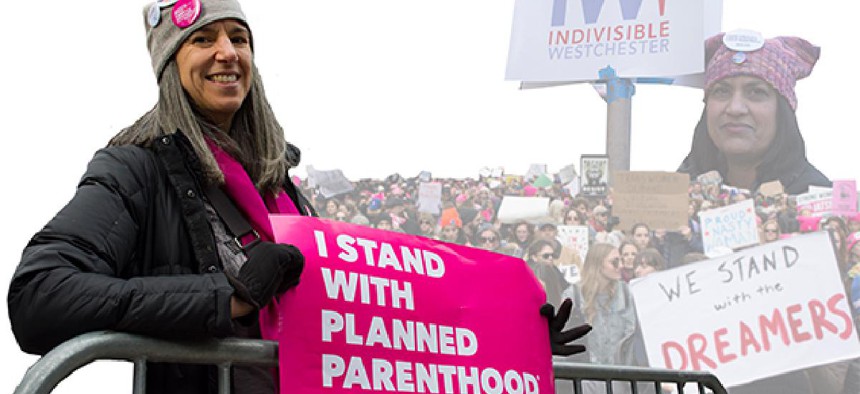A year into Trump Presidency, New Yorkers Resist Through Nonprofits

Illustration by Zach Williams/ NYN Media
One year ago, Port Washington resident Robin Sigman was looking for a way to become a part of the fledgling resistance movement against incoming President Donald Trump.
Like millions of other people, she feared what his campaign promises would mean in action for immigrants, women, LGBT people and American democracy more generally. The 2016 election appeared to be an extraordinary moment that required her to act. So she turned to a local organization in order to channel this energy into action. And in that way Sigman confronted a federal immigration crackdown and the Trump administration more broadly through the hours she volunteered at organizations like Long Island Together, a Nassau County group that offers free legal clinics for immigrants.
Stepping out from her daily routine was of the essence even when it just involved a little time babysitting for clients or helping out around the office, according to Sigman.
"I try to put myself in places where I’m a little uncomfortable I want to know about all of the different areas that Trump is affecting (other people) that maybe aren’t part of my world,” she said in an interview one year later.

Pink "pussy hats" are a ubquitous symbol of the ongoing Women's March movement. (Photos by Zach Williams/ NYN Media.)
By then she was on Sixth Avenue in Manhattan as more than 100,000 people participated in New York City’s 2018 Women’s March. At the march this past Saturday, she carried a sign in support of Planned Parenthood, one of many nonprofits that made their presence known through this latest demonstration of a newly-emboldened national women’s movement – much of it directed against the president.
Nonprofits have been a beneficiary of the political awakening of women such as Sigman who have inserted themselves into a nationwide surge in volunteerism, powered a spike in donations to nonprofit groups like the NYCLU, and led to a growing progressive wave at the local political level in Westchester County, where groups like Indivisible Westchester helped Democrats pick up three seats during a recent county legislature election.
"That was amazing because I don’t think we imagined that people would have so much passion for local elections,” said Gaby Bordwin, a member of sister group Indivisible Rivertowns.
Grassroots groups like this have measured success through the ballot box and the organization it requires, whether through social media campaigns or community meetings that drew hundreds more people than anticipated, she added. As the groups near their one-year anniversary, they count thousands of members between them, said Borden.
“People are looking for a place to help,” she said. "It was they who came to us more than we needed to find them.”

More than 100,000 people were mobilized by the nonprofit that organized the Jan. 20 Women's March in New York City.
The biggest nonprofit of them all on Jan. 20 was the New York City march itself, organized by the Women’s March Alliance. The group incorporated independently from the group that organized last year’s main march in Washington, a group that has gotten some publicity for its efforts to control the Women’s March brand.
But the high-level disputes were not on the minds of those who spoke to NYN Media one year after Donald Trump’s inauguration. Turnout had been high, just like the year before and when asked what they did day to day as part of the resistance to the administration, participants said that their success depended on how well individual outrage can be channeled into organized efforts. Much of the march consisted of the collective mass of groups as large as Planned Parenthood, or as seemingly uninvolved in women’s issues per se as Gays Against Guns.
But one by one, all of this energy would one day culminate in the one act that ultimately mattered, the most direct way to ensure their greatest shared goal of a Trump-free White House would materialize.
Nonprofit efforts to protect women’s rights, highlight immigration issues and mobilize street protests lead to one all-important moment, according to Sigman.
“When people have access to voting and can get to the polls and cast their vote, that’s what it’s all about,” she said.

Women made up a majority of the people who marched on Jan. 22 but many men also advocated for gender equality.
